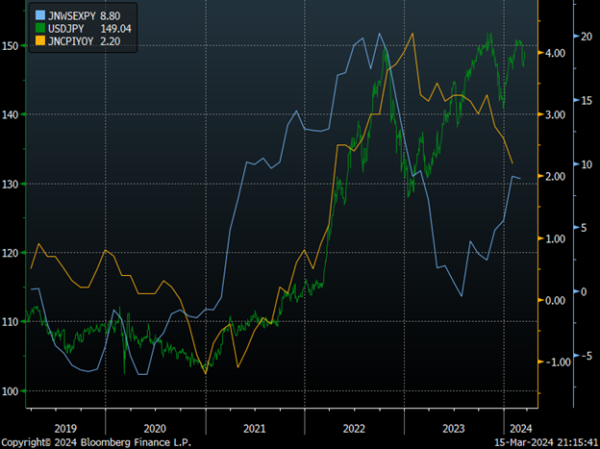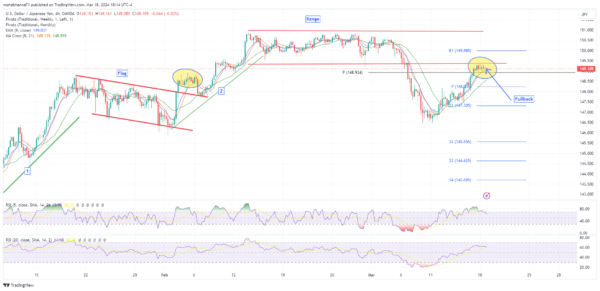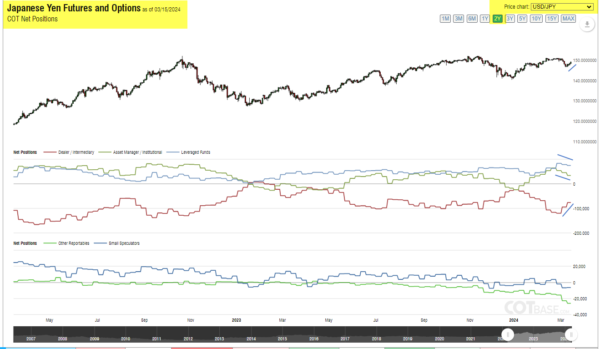BOJ Policy Rate
The Bank of Japan is scheduled to announce its Policy Rate, Monetary Policy Statement, and BOJ Press Conference. Japan has held its interest rates at record-low levels for almost 17 years. The current interest rate is—0.10%, and according to Bloomberg analysts’ surveys, the BOJ is expected to maintain this level for the March 2024 BOJ meeting. Japan’s economy endured two decades of deflationary pressure, with the post-COVID inflation rate rising globally; Japan’s CPI Nationwide YoY, a measure of the inflation rate, crossed above the zero level in late 2021, reaching a high of 4.26% in January 2023. This was followed by a decline as the inflationary pressure eased globally. The current inflation rate in Japan stands at 2.2%, slightly above BOJ’s target of 2%. Japan’s most important union group announced stronger-than-expected annual wage deals on Friday, thus adding weight to BOJ rate hike odds.
According to the Bloomberg World Interest Rate Probability Model, it is estimated that markets have priced in a 56.1% chance of a 0.056% hike, bringing the current Implied O/N Rate up from -0.009% up to 0.047%. In another poll by Reuters, just under two-thirds of economists polled by Reuters expect the BOJ to end negative rates in April. Japan’s CPI YoY contribution breakdown shows that the decline is reflected in almost all categories, including food, fuel, and utilities, while the only noticeable increase was in the Recreation and Culture Services sector.
Source: Bloomberg Terminal
Exports mainly drive Japan’s economy, and the yen’s value against the US Dollar can significantly affect overall economic performance. The above chart shows the correlation between Japan’s export price index JNWSEXPY (Blue line) and USDJPY (Green bars), while the yellow line represents Japan’s CPI – JNCPIYOY. The recent increase in the export index is not in line with inflation and was possibly driven by a weak yen, which may be undervalued, thus less of a negative impact on Japan’s economy in case of a BOJ hike.
4 – Hour Chart
Source: Tradingview.com
- Price action was trading in an uptrend (Trendline1), followed by flag formation.
- Price broke out above the flag formation and resumed its uptrend (Trendline2), followed by a range trading pattern. Price action broke below the trading range and is currently in a pullback mode, finding resistance below the breakout level (the lower border of the trading range); the same level was a resistance in early Feb 2024. (Yellow ellipse)
- Price is trading above its fast and intermediate moving averages, EMA9, MA9, and MA21; the intersection of the three averages may represent a confluence of support if the price fails to reenter the broken trading range.
- The fast RSI is at the overbought level and in line with price action, while the smoothed RSI points down after reaching level 66, just below overbought.
Commitment of Traders Report
Source: Cotbase.com
The COT report for the week ending on March 15th, 2024 (Includes data up to the end of day Tuesday, March 12th, 2024) reflects the three TIFF report categories, Asset Manager/Institution, Leveraged Funds, and Dealer/Intermediary, all reflect negative divergence with price action. (Image flipped to USDJPY)















